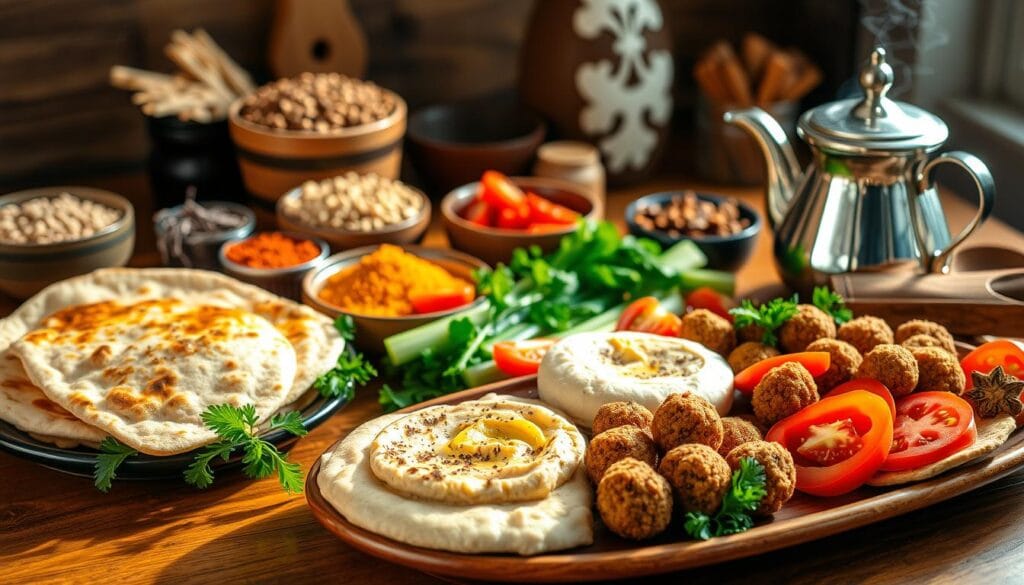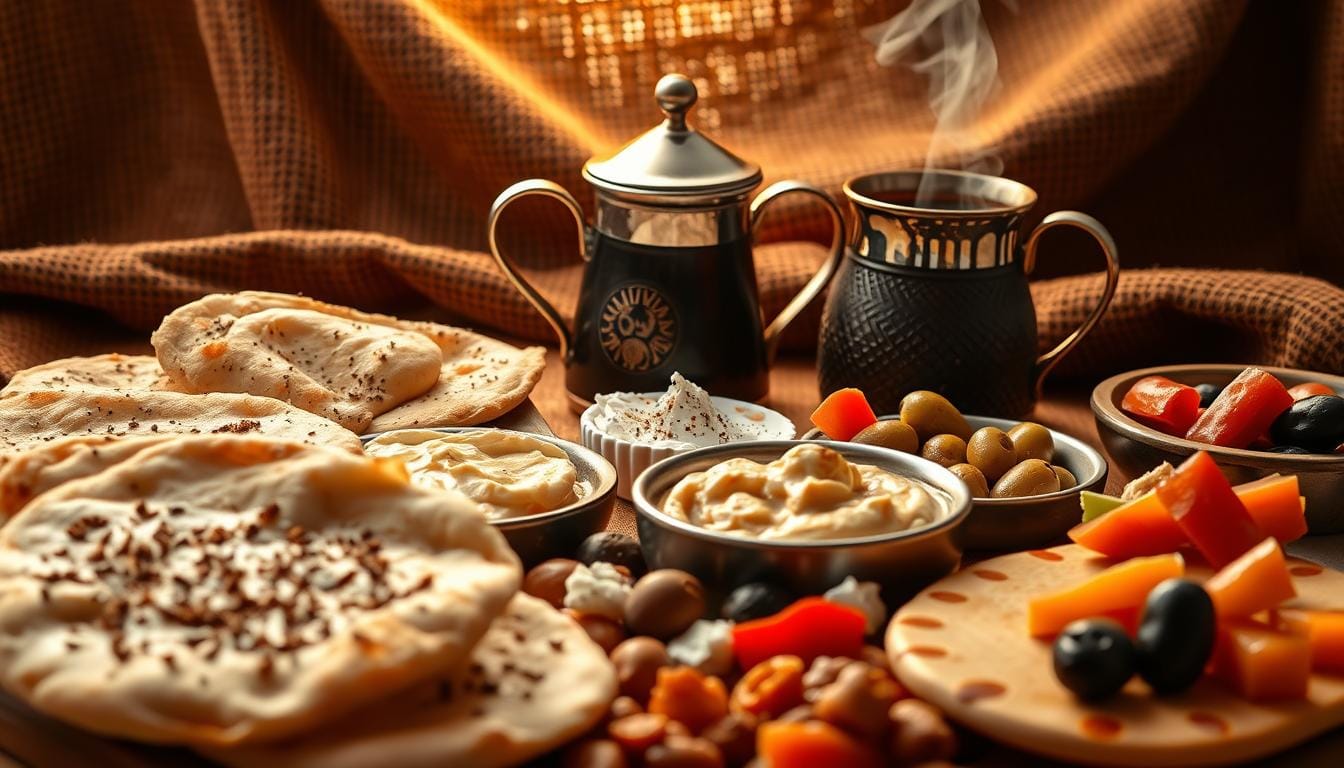Imagine starting your day with a delicious arabic breakfast. It’s filled with the smells of spices and fresh ingredients. Traditional middle eastern breakfasts offer many choices, from hearty egg dishes to sweet pastries. With a bit of practice, you can make these recipes a daily part of your life.
Arabic breakfasts are known for their bold flavors and smells. They use fresh ingredients and spices. Dishes like musabaha and shakshuka are favorites. By trying these recipes, you can enjoy the rich tastes and traditions of the middle east.
With the right ingredients and a bit of practice, you can make tasty arabic breakfasts at home. There are traditional dishes like shakshuka and musabaha, as well as modern twists. So, why not start your day with a taste of the middle east?
Key Takeaways
- Arabic breakfast food recipes offer a wide range of options for a delicious and flavorful start to the day.
- Traditional middle eastern breakfast dishes like shakshuka and musabaha are staples of the cuisine.
- Arabic breakfast food recipes focus on fresh ingredients and spices, with bold flavors and aromas.
- With practice, you can easily make arabic breakfast food recipes at home, and experience the rich tradition of middle eastern cuisine.
- Modern variations and twists on traditional arabic breakfast food recipes offer something for everyone.
- Arabic breakfast food recipes can be adapted to suit different dietary needs and preferences, such as low-fat or low-carb options.
Understanding the Rich Tradition of Arabic Breakfast Culture
Exploring Arabic breakfast reveals a tradition that values sharing meals with others. In Arabic culture, breakfast is a time for family and friends to gather. They share a meal, creating a sense of community and togetherness. Easy arabic breakfast ideas like shakshuka and musabaha are simple yet delicious.
Homemade breakfast recipes from arabia focus on fresh ingredients and traditional cooking. Common breakfast items include labneh, hummus, eggs, and fresh vegetables. Each dish is made with care, blending flavors and textures perfectly.
At the core of Arabic breakfast culture is hospitality. Guests are welcomed with a warm meal. This tradition strengthens community bonds during breakfast. Whether it’s a traditional Emirati breakfast or a modern take, the experience is memorable.
- Shakshuka: a flavorful egg dish made with tomatoes and spices
- Musabaha: a warm chickpea dish with tahini and garlic
- Labneh: a strained yogurt often served with olive oil and za’atar
These dishes are just a few examples of the many easy arabic breakfast ideas and homemade breakfast recipes from arabia to try. Their rich flavors and aromas will make them a part of your breakfast routine.
Essential Ingredients for Arabic Breakfast Food Recipes
Preparing delicious middle eastern morning meals starts with the right ingredients. Traditional ingredients and spices are key to bold flavors and aromas. Olive oil, garlic, cumin, and paprika are must-haves.
For tasty middle eastern breakfasts, keep fava beans, chickpeas, and pita bread ready. Fresh fruits and veggies add vitamins and nutrients. These ingredients help make dishes like ful medames and manakeesh with za’atar and cheese.
Labneh, a strained yogurt, is also important for its protein and probiotics. Sumac and aleppo pepper add unique flavors. Using these ingredients, you can make authentic arabian breakfasts that impress.
| Ingredient | Description |
|---|---|
| Olive Oil | Used for cooking and adding flavor |
| Garlic | Added to dishes for flavor and aroma |
| Cumin | Used to add warmth and depth to dishes |
| Paprika | Added to dishes for color and flavor |
With these ingredients, you can make many delicious middle eastern breakfasts. From ful medames to manakeesh, arabian breakfasts will become a favorite in your home.
Must-Have Kitchen Tools for Authentic Arabic Cooking
Exploring Saudi Arabian breakfast recipes means you need the right tools. Healthy Middle Eastern breakfasts often call for traditional cookware. This includes a clay oven or a mortar and pestle for dishes like shakshuka and ful medames.
To make authentic Arabic dishes, you’ll need both old and new tools. Start with a quality clay oven or a heavy-bottomed pot for slow cooking.
Traditional Cookware
Arabic cooking uses copper pots, clay ovens, and wooden utensils. These tools spread heat evenly and add flavor to dishes.
Modern Alternatives for Arabic Cooking
Today, Arabic cooks also use modern tools like electric mixers and food processors. But, traditional cookware is still the best for keeping heat and flavors.
With the right kitchen tools, you can make tasty and authentic Arabic dishes. This includes popular Saudi Arabian breakfast recipes and healthy Middle Eastern options.
Mastering the Art of Arabic Bread Making
Arabic bread making is key to simple arabic breakfast dishes. It can make your breakfast much better. You’ll need to know about different breads like pita, naan, and khubz. These are all important in middle eastern breakfast foods.
Making arabic bread involves mixing, kneading, and baking. The flour type, temperature, and humidity matter a lot. Getting the measurements right and kneading well is important. It helps the bread be chewy and elastic.
Some popular arabic breads include:
- Pita bread, which needs high heat and steam for its pocket
- Naan, traditionally cooked in a tandoor oven but can also be made in a cast iron skillet
- Khubz, a thick, round flatbread often served with stews and main courses
With practice and patience, you can become great at making arabic bread. You’ll make delicious, authentic breads. These will enhance your simple arabic breakfast dishes and flavorful middle eastern breakfast foods.
Classic Arabic Breakfast Egg Dishes
Eggs are a key ingredient in arabic breakfast recipes. They’re found in many traditional dishes because they’re versatile and full of protein. Shakshuka is a favorite, with eggs, tomatoes, and spices.
There are many other egg dishes to try. Ejjeh is a Lebanese dish with eggs, garlic, and spices. Fool medames is a stew with fava beans, garlic, and eggs.
These dishes are tasty and easy to make. With simple ingredients and basic cooking, you can make a great arabic breakfast. Whether you like spicy or comforting dishes, there’s something for everyone.
Make sure you have eggs, tomatoes, garlic, and spices ready. Also, have crusty bread or pita for the sauce. With these ingredients, you’ll soon be making delicious arabic breakfasts.
Traditional Arabic Breakfast Food Recipes You Can Make Today
Looking for easy Arabic breakfast ideas? You’ve got plenty of tasty options. Shakshuka is a favorite, with its eggs, tomatoes, and spices. Musabaha is another hit, featuring chickpeas, tahini, and garlic.
Want to try homemade breakfast recipes from Arabia? Ful medames is a great pick. It’s made with fava beans, garlic, and lemon, served with warm pita. Ta’ameya and shanklish are also easy to make and delicious.
These recipes are not only yummy but also healthy and simple. You can make traditional Arabic breakfasts at home with fresh ingredients. Whether you like sweet or savory, there’s something for everyone.
Delicious Arabic Breakfast Spreads and Dips
Arabic breakfast spreads and dips are a must-try. They add rich flavors and hearty ingredients to your morning. Hummus, made from chickpeas, tahini, garlic, and lemon, is a favorite. Labneh, a creamy yogurt cheese, is also popular, often served with olive oil, za’atar, and pita bread.
These dips are not just tasty but also nutritious. Hummus is full of protein and fiber, making it a healthy breakfast choice. Labneh, rich in protein and calcium, keeps you full and energized. Paired with whole grain pita or veggies, they make a satisfying breakfast.
There are many more Arabic breakfast spreads and dips to explore. Muhammara, a spicy dip from roasted red peppers, and baba ganoush, a creamy eggplant dip, are just a few examples. These dips go well with pita, veggies, and crackers, making breakfast easy and fun.
Nutritional Benefits of Arabic Breakfast Spreads and Dips
- High in protein and fiber
- Good source of calcium and vitamins
- Can be made with healthy ingredients like olive oil and whole grains
- Can be served with a variety of foods for a well-rounded breakfast
Arabic breakfast spreads and dips are a tasty and healthy way to begin your day. Their rich flavors and hearty ingredients make them a breakfast staple. Whether you love hummus, labneh, or other options, there’s something for everyone.
| Dip | Ingredients | Nutritional Benefits |
|---|---|---|
| Hummus | Chickpeas, tahini, garlic, lemon juice | High in protein and fiber |
| Labneh | Yogurt cheese, olive oil, za’atar | Good source of protein and calcium |
| Muhammara | Roasted red peppers, walnuts, breadcrumbs | High in vitamins and antioxidants |
Sweet Arabic Morning Treats
Sweet treats are a big part of Saudi Arabian breakfasts. Baklava and kunafeh are two favorites that are great for breakfast or brunch. They pair well with healthy options like fresh fruits and yogurt.
Ma’amoul cookies are another must-try. They’re a classic dessert enjoyed during Eid al-Fitr. These cookies have a shortbread-like dough and are filled with dates or nuts.
Other treats include stuffed dates and kahk, a butter cookie filled with date paste. These are part of Arabic breakfast culture, offering a taste of Middle Eastern hospitality.
Other sweet treats include:
* Saviya, a stir-fried vermicelli dish from south asia
* Kanafeh, a dessert with shredded phyllo dough and white cheese
* Qatayef, a middle eastern pancake enjoyed during Ramadan
These treats showcase the variety and flavor of Arabic breakfasts, making for a healthy and tasty start to the day.
Healthy Middle Eastern Breakfast Options
There are many healthy options for simple arabic breakfast dishes. Middle Eastern breakfast foods often use whole grains, fruits, and vegetables. These ingredients make for a nutritious start to the day and can be mixed in many ways.

Nutritious Ingredient Choices
Ingredients like whole grains and fresh fruits are used in these dishes. Oats, barley, dates, and citrus are examples. They taste great and offer health benefits like fiber, vitamins, and minerals.
Plant-Based Arabic Breakfast Ideas
For plant-based options, there are many tasty choices. Dishes like ful medames and shakshuka are made with plant-based ingredients. They are not only tasty but also packed with protein, fiber, and vitamins.
Arabic Breakfast Beverages and Tea Customs
Exploring arabic breakfast food recipes reveals a world of drinks. Traditional middle eastern breakfast dishes come with a variety of beverages. From arabic coffee to herbal teas, these drinks are key to the Middle East’s breakfast culture.
In this region, coffee is a big part of breakfast. Arabic coffee is known for its strong flavor and aroma. It’s made from finely ground coffee beans and cardamom. Often, it’s served in small cups with dishes like ful medames and pita bread.
Traditional Arabic Coffee Preparation
To make traditional arabic coffee, grind coffee beans and cardamom together. Then, brew them in a small pot called an ibrik or cezve. The coffee is served in small cups, often with a sweet treat like dates or baklava.
Herbal Tea Selections
Herbal teas are also popular in the Middle East. Mint tea is a favorite, made by steeping fresh mint leaves in hot water. Other teas like chamomile and hibiscus are enjoyed for their calming and refreshing qualities.
When it comes to arabic breakfast food recipes, drinks are as important as the dishes. Whether you like traditional arabic coffee or a soothing herbal tea, there’s a drink for every traditional middle eastern breakfast dish.
These beverages are a big part of the arabic breakfast tradition. They’re often enjoyed with traditional middle eastern breakfast dishes like ful medames, pita bread, and labneh.
Time-Saving Tips for Arabic Breakfast Preparation
Preparing Arabic breakfast dishes can be quick if you plan well. Use easy arabic breakfast ideas and pre-made ingredients to save time. This way, you can make tasty meals without spending hours in the kitchen.
Another smart move is to cook in bulk. This method is great for making homemade breakfast recipes from arabia efficiently. For instance, cooking a big batch of ful medames or shakshuka lets you use it later. It’s perfect for busy days.
Here are more tips to save time:
- Prepare ingredients ahead, like chopping veggies or marinating meats.
- Use a slow cooker for dishes like stews or soups.
- Keep pre-cooked grains, like rice or bulgur, for quick meals.
With these tips, you can make tasty Arabic breakfasts without wasting time. Whether you’re after easy arabic breakfast ideas or want to try homemade breakfast recipes from arabia, planning and prep are key. Enjoy a delicious and fulfilling meal with a little effort.
Serving and Presentation Techniques
When serving delicious middle eastern morning meals, aim for a warm and inviting vibe. Use traditional table settings like patterned ceramics and colorful textiles. This adds authenticity to the dining experience.
A well-set table makes authentic arabian breakfast cuisine a feast for the eyes and taste buds. Add decorative elements like fresh flowers or fruit to welcome guests.

Traditional Table Settings
Traditional table settings mix modern and traditional elements. Think ornate silverware and handmade ceramics. Combine these with modern touches like vibrant tablecloths or statement artwork for a unique setting.
Modern Plating Ideas
Modern plating adds sophistication to delicious middle eastern morning meals. Use colors and textures to make dishes visually appealing. For example, a bowl of shakshuka with fresh herbs and feta cheese looks great.
Here are some modern plating ideas for authentic arabian breakfast cuisine:
- Use small plates and bowls for a sense of abundance.
- Add fresh herbs and edible flowers for color.
- Make a statement with a large platter or decorative bowl.
Creating an Arabic Breakfast Meal Plan
When planning an Arabic breakfast menu, focus on a mix of popular Saudi Arabian breakfast recipes and healthy Middle Eastern breakfast options. This ensures a balanced and tasty start to your day. Start with classics like shakshuka and ful medames. They are filling and full of traditional spices.
For a balanced meal, choose dishes with high protein and moderate carbs. Think eggs, labneh, and whole-grain pita bread. Add fresh veggies, herbs, and healthy fats for essential nutrients. With some planning, you can make an Arabic breakfast that’s both satisfying and healthy.
FAQ
What are the traditional middle eastern breakfast dishes?
What are the essential ingredients used in Arabic breakfast food recipes?
What are the must-have kitchen tools for authentic Arabic cooking?
How can I master the art of Arabic bread making?
What are some classic Arabic breakfast egg dishes?
What are some traditional Arabic breakfast food recipes that I can make at home?
What are some popular Arabic breakfast spreads and dips?
What are some healthy Middle Eastern breakfast options?
What are the traditional Arabic breakfast beverages and tea customs?
What are some time-saving tips for Arabic breakfast preparation?
How can I create an inviting Arabic breakfast table?
How can I plan an Arabic breakfast meal plan?
Table of Contents
Did you like this recipe?
There are no reviews yet. Be the first one to write one.

